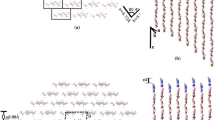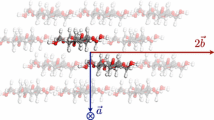Abstract
Crystallography indicates that molecules in crystalline cellulose either have twofold screw-axis (21) symmetry or closely approximate it, leading to short distances between H4 and H1′ across the glycosidic linkage. Therefore, modeling studies of cellobiose often show elevated energies for 21 structures, and experimental observations are often interpreted in terms of intramolecular strain. Also, some computer models of cellulose crystallites have an overall twist as well as twisted individual chains, again violating 21 symmetry. To gain insight on the question of inherent strain in 21 structures, modeling was employed and crystal structures of small molecules were surveyed. (Residues in a disaccharide cannot be related by 21 symmetry because they are not identical but if their linkage geometry would lead to 21 symmetry for an infinite cellulose chain, the disaccharide would have 21 pseudo symmetry.) Several initial structures in quantum mechanics (QM) studies of cellobiose minimized to structures having 21 pseudo symmetry. Similarly, a number of relevant small molecules in experimental crystal structures have pseudo symmetry. While the QM models of cellobiose with 21 pseudo symmetry had inter-residue hydrogen bonding, the experimental studies included cellotriose undecaacetate, a molecule that cannot form conventional hydrogen bonds. Limitations in characterizing symmetry based on the linkage torsion angles ϕ and ψ were also explored. It is concluded that 21 structures have little intrinsic strain, despite indications from empirical models.











Similar content being viewed by others
References
Allen FH (2002) The Cambridge structural database: a quarter of a million crystal structures and rising. Acta Crystallogr Sect B 58:380–388
Atalla RH (1979) Conformational effects of the hydrolysis of cellulose. Adv Chem Ser 181:55–69
Basma M, Sundara S, Calgan D, Venali T, Woods R (2001) Solvated ensemble averaging in the calculation of partial atomic charges. J Comput Chem 22:1125–1137
Bowling AJ, Amano Y, Lindstrom R, Brown RM Jr (2001) Rotation of cellulose ribbons during degradation with fungal cellulase. Cellulose 8:91–97
Brooks BR, Bruccoleri RE, Olafson BD, States DJ, Swaminathan S, Karplus M (1983) CHARMM: a program for macromolecular energy, minimization, and dynamics calculations. J Comput Chem 4:187–217
Case DA, Darden TA, Cheatham TAIII, Simmerling CL, Wang J, Duke RE, Luo R, Merz KM, Pearlman DA, Crowley M, Walker RC, Zhang W, Wang B, Hayik S, Roitberg A, Seabra G, Wong KF, Paesani F, Wu X, Brozell S, Tsui V, Gohlke H, Yang L, Tan C, Mongan J, Hornak V, Cui G, Beroza P, Mathews DH, Schafmeister C, Ross WS, Kollman P (2006) Amber 9. University of California, San Francisco
Chu SSC, Jeffrey GA (1968) The refinement of the crystal structures of β-d-glucose and cellobiose. Acta Crystallogr Sect B: Struct Crystallogr Cryst Chem 24:830–838
French AD (1989) Computer models of cellulose. In: Scheurch C (ed) Cellulose and wood—chemistry and technology. Wiley, New York, pp 103–118
French AD, Johnson GP (2004) What crystals of small analogs are trying to tell us about cellulose structure. Cellulose 11:5–22
French AD, Johnson GP (2006) Quantum mechanics studies of cellobiose conformations. Can J Chem 84:603–612
French AD, Johnson GP (2007a) Cellulose shapes. In: Brown RM Jr, Saxena IM (eds) Cellulose: molecular and structural biology. Springer, Dordrecht, pp 257–284
French AD, Johnson GP (2007b) Linkage and pyranosyl ring twisting in cyclodextrins. Carbohydr Res 342:1223–1237
French AD, Johnson GP (2008) Roles of starting geometries in quantum mechanics studies of cellobiose. Mol Simul 34:365–372
French AD, Murphy VG (1973) The effects of changes in ring geometry on computer models of amylose. Carbohydr Res 27:391–406
French AD, Kelterer A-M, Johnson GP, Dowd MK, Cramer CJ (2000) Constructing and evaluating energy surfaces of crystalline disaccharides. J Mol Graph Model 18:95–107
Gessler K, Krauss N, Steiner T, Betzel C, Sarko A, Saenger W (1995) β-d-Cellotetraose hemihydrate as a structural model for cellulose II. An X-ray diffraction study. J Am Chem Soc 117:11397–11406
Gray DG (1996) Chirality in cellulose and cellulose-based materials. Polym Prepr (Div. Polym Sci., Am Chem Soc) 37:485–486
Ham JT, Williams DG (1970) The crystal and molecular structure of methyl β-cellobioside-methanol. Acta Crystallogr Sect B: Struct Crystallogr Cryst Chem 26:1373–1383
Hanley SJ, Revol J, Godbout L, Gray D (1997) Atomic force microscopy and transmission electron microscopy of cellulose from Micrasterias delliculara; evidence for a chiral helical microfibril twist. Cellulose 4:209–220
Hirai A, Tuji M, Horii F (1998) Helical sense of ribbon assemblies and splayed microfibrils of bacterial cellulose. Sen’I Gakkaishi 54:506–510
Jones PG, Kirby AJ, Glenn R, Haedicke E (1982) Crystal structures of acetals. Part 12. The crystal structure of 3, 4-dinitrophenyl-β-d-glucopyranoside hydrate. Z Kristallogr 161:127–136
Kirchner KN, Woods R (2001a) Solvent interactions determine carbohydrate conformation. Proc Natl Acad Sci USA 98:10541–10545
Kirchner KN, Woods R (2001b) Quantum mechanical study of the nonbonded forces in water-methanol complexes. J Phys Chem A 105:4150–4155
Kuttel M, Brady JW, Naidoo KJ (2002) Carbohydrate solution simulations: producing a force field with experimentally consistent primary alcohol rotational frequencies and populations. J Comput Chem 23:1236–1243
Langan P, Nishiyama Y, Chanzy H (2001) X-ray structure of mercerized cellulose II at 1 Å resolution. Biomacromolecules 2:410–416
Linden A, Calis I, Neuburger M, Sticher O (2000) Asperuloside monohydrate. Acta Crystallogr Sect C: Cryst Struct Commun 56:616–618
Mackie W, Sheldrick B, Akrigg D, Perez S (1986) Crystal and molecular structure of mannotriose and its relationship to the conformations and packing of mannan and glucomannan chains and mannobiose. Int J Biol Macromol 8:43–51
Matthews JF, Skopec CE, Mason PE, Zuccato P, Torget RW, Sugiyama J, Himmel ME, Brady JW (2006) Computer simulation studies of microcrystalline cellulose Iß. Carbohydr Res 341:138–152
Nishiyama Y, Langan P, Chanzy H (2002) Crystal structure and hydrogen-bonding system in cellulose Iβ from synchrotron X-ray and neutron fiber diffraction. J Am Chem Soc 124:9074–9082
Nishiyama Y, Sugiyama J, Chanzy H, Langan P (2003) Crystal structure and hydrogen bonding system in cellulose Iα from synchrotron X-ray and neutron fiber diffraction. J Am Chem Soc 125:14300–14306
Nishiyama Y, Johnson GP, French AD, Forsythe VT, Langan P (2008) Neutron crystallography, molecular dynamics, and quantum mechanics studies of the nature of hydrogen bonding in cellulose. Biomacromolecules 9:3133–3140
Noordik JH, Beurskens PT, Bennema P, Visser RA, Gould RO (1984) Crystal structure, polarity and morphology of 4-O-β-d-galactopyranosyl-α-d-monohydrate (a-lactose monohydrate): a redetermination. Z Kristallogr 168:59–65
Palma R, Zuccato P, Himmel ME, Liang G, Brady JW (2000) Molecular mechanics studies of cellulases. ACS Symp Ser 769:112–130
Pan Q, Noll BC, Serianni AS (2005) Methyl 4-O-β-d-galactopyranosyl α-d-glucopyranoside (methyl α-lactoside). Acta Crystallogr Sect C: Cryst Struct Commun 61:o674–o677
Parvez M, Atta-ur-Rahman, Choudhary MI, Zareen S, Akhtar NM, Shujaat S, Ngounou FN (2004) Arjunglucoside I chloromethane 0.25-solvate monohydrate. Acta Crystallogr Sect E: Struct Rep Online 60:o2130–o2132
Pedersen BF, Karlsen J (1978) The crystal and molecular structure of apterin C20H24O10.H2O (vaginidiol monoglucoside), 8-[2-(glucosyloxy)isopropyl]-9-hydroxy-8, 9-dihydroangelicin. Acta Crystallogr Sect B: Struct Crystallogr Cryst Chem 34:1893–1897
Peralta-Inga Z, Johnson GP, Dowd MK, Rendleman JA, Stevens ED, French AD (2002) The crystal structure of the α-cellobiose 2NaI·2H2O complex in the context of related structures and conformational analysis. Carbohydr Res 337:851–861
Perez S, Brisse F (1977) The crystal and molecular structure of a trisaccharide, β-cellotriose undecaacetate: 1, 2, 3, 6-tetra-O-acetyl-4-O-[2, 3, 6-tri-O-acetyl-4-O-(2, 3, 4, 6-tetra-O-acetyl-β-d-glucopyranosyl)-β-d-glucopyranosyl]-β-d-glucopyranose. Acta Crystallogr Sect B 33:2578–2584
Pettersen EF, Goddard TD, Huang CC, Couch GS, Greenblatt DM, Meng EC, Ferrin TE (2004) UCSF Chimera—a visualization system for exploratory research and analysis. J Comput Chem 25:1605–1612
Rajnikant, Lal M, Gupta VK, Singh A, Suri OP (1998) Crystal structure of 1α-(β-d-Glucopyranosyloxy)-1,4aα,5,6,7,7aα-Hexahydro-7α-Methyl-5- Oxocyclopenta[c]pyran- 4-Carboxylic Acid Methyl Ester (Verbenalin). Kristallografiya (Russ) (Crystallogr Rep) 43:448
Raymond S, Henrissat B, Qui DT, Kvick A, Chanzy H (1995) The crystal structure of methyl β-cellotrioside monohydrate 0.25 ethanolate and its relationship to cellulose II. Carbohydr Res 277:209–229
Rees DA, Skerrett RJ (1968) Conformational analysis of cellobiose, cellulose and xylan. Carbohydr Res 7:334–348
Rencurosi A, Rohrling J, Pauli J, Potthast A, Jager C, Perez S, Kosma P, Imberty A (2002) Polymorphism in the crystal structure of the cellulose fragment analogue Methyl 4-O-Methyl-β-d-Glucopyranosyl-(1–4)-β-d-Glucopyranoside. Angew Chem Int Ed 41:4277–4281
Sheldrick B, Mackie W, Akrigg D (1984) The crystal and molecular structure of O-β-d-mannopyranosyl-(1, 4)-α-d-mannopyranose (mannobiose). Carbohydr Res 132:1–6
Shimanouchi T, Mizushima S-I (1955) On the helical configuration of a polymer chain. J Chem Phys 33:707–711
Strati GL, Willett JL, Momany FA (2002) Ab initio computational study of β-cellobiose conformers using B3LYP/6–311++G**. Carbohydr Res 337:1833–1849
Viëtor RJ, Mazeau K, Lakin M, Pérez S (2000) A priori crystal structure prediction of native celluloses. Biopolymers 54:342–354
Viëtor RJ, Newman RH, Ha M-A, Apperley DC, Jarvis MC (2002) Conformational features of crystal-surface cellulose from higher plants. Plant J 30:721–731
Wada M, Chanzy H, Nishiyama Y, Langan P (2004) Cellulose IIII crystal structure and hydrogen bonding by synchrotron X-ray and neutron fiber diffraction. Macromolecules 37:8548–8555
Wada M, Heux L, Nishiyama Y, Langan P (2009) X-ray crystallographic, scanning microprobe X-ray diffraction, and cross-polarized/magic angle spinning 13C NMR studies of the structure of cellulose IIIII. Biomacromolecules 10:302–309
Yoneda Y, Mereiter K, Jaeger C, Brecker L, Kosma P, Rosenau T, French AD (2008) Van der Waals vs. hydrogen-bonding forces in a crystalline analog of cellotetraose: cyclohexyl 4′-O-cyclohexyl β-d-cellobioside-cyclohexane solvate. J Am Chem Soc 130:16678–16690
Yui T, Nishimura S, Akiba S, Hayashi S (2006) Swelling behavior of the cellulose Iß crystal models by molecular dynamics. Carbohyr Res 341:2521–2530
Zhao C, Liu Q, Halaweish F, Ye Y, Zhao W (2003) Copacamphane, picrotoxane, and alloaromadendrane sesquiterpene glycosides and phenolic glycosides from Dendrobium moniliforme. J Nat Prod 66:1140–1143
Acknowledgments
This work was funded by normal research funding from the Agricultural Research Service, CRIS project 44000-6435-070-00D. We thank Professor Carlos Stortz, Dr. Michael Santiago Cintrón and Dr. James Rodgers for helpful comments on the paper.
Author information
Authors and Affiliations
Corresponding author
Rights and permissions
About this article
Cite this article
French, A.D., Johnson, G.P. Cellulose and the twofold screw axis: modeling and experimental arguments. Cellulose 16, 959–973 (2009). https://doi.org/10.1007/s10570-009-9347-4
Received:
Accepted:
Published:
Issue Date:
DOI: https://doi.org/10.1007/s10570-009-9347-4




